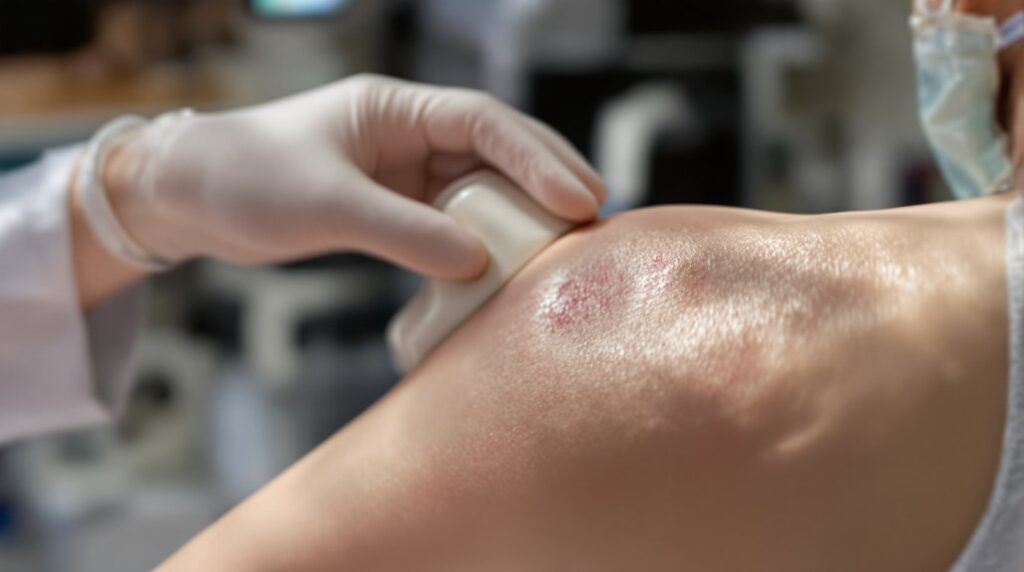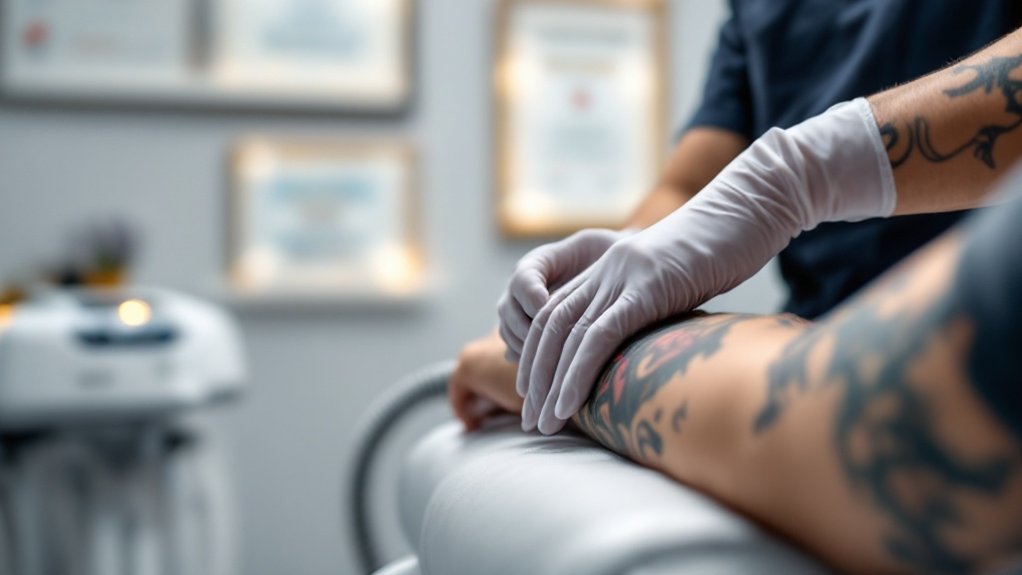Posted by: Skin And Cancer Institute in Uncategorized

In California, safe tattoo removal must be performed by licensed physicians, PAs, RNs, or nurse practitioners using FDA-approved Class II lasers. We conduct thorough consultations to create individualized treatment plans based on tattoo age, color, and location. Expect multiple sessions with proper pain management. Complications occur in about 5% of procedures, with blistering common. Financial assistance programs exist for qualifying patients. The following sections outline everything you need for successful tattoo removal.
Key Takeaways
- Only licensed physicians, PAs, RNs, and nurse practitioners can legally perform tattoo removal in California, with non-physicians requiring direct supervision.
- FDA-approved Class II laser devices utilizing selective photothermolysis are the standard technology for safe and effective tattoo removal.
- Thorough patient consultation, including assessment of tattoo characteristics and medical history, is essential before beginning treatment.
- Multiple treatment sessions are typically required, with results varying based on tattoo size, ink colors, and depth.
- Free and reduced-cost tattoo removal programs exist throughout California for qualifying individuals, particularly youth with gang-related tattoos.
California’s Legal Requirements for Tattoo Removal Practitioners

Five distinct categories of professionals are legally authorized to perform tattoo removal procedures in California, each with specific supervision requirements. Licensed physicians may independently conduct laser tattoo removal, while PAs, RNs, and nurse practitioners must operate under direct physician supervision. This oversight remains mandatory regardless of laser equipment type.
We’re committed to maintaining the highest standards of practitioner qualifications in our practice. All legal personnel performing these procedures must complete bloodborne pathogen training annually, document Hepatitis B vaccination, and fulfill county-approved training programs. It’s important to keep all licensing documentation updated to avoid issues with renewals and potential practice interruptions.
It’s important to understand that certain professionals—including unlicensed medical assistants, LVNs, cosmetologists, electrologists, and estheticians—are strictly prohibited from performing laser tattoo removal under California law, even with supervision.
Laser Tattoo Removal Technology and Safety Protocols
Understanding the technology behind tattoo removal is just as important as knowing who can legally perform the procedure. At Skin and Cancer Institute, we utilize FDA-approved Class II laser devices that operate on the principle of selective photothermolysis to target tattoo pigments.
Our advanced lasers emit precise wavelengths that fragment ink particles while minimizing damage to surrounding tissue. Different wavelengths effectively target various ink colors, ensuring thorough removal. These fragmented pigments are then naturally eliminated by your body’s immune system.
We strictly adhere to regulatory safety protocols, maintaining sterile environments and properly calibrated equipment. Complete removal typically requires multiple sessions based on your tattoo’s size, colors, and depth. Our dermatologists are extensively trained in laser technology and safety protocols to deliver ideal results while preventing complications like scarring or infection. In California, licensed physicians only can legally perform tattoo removal procedures or supervise those performing them.
Patient Consultation and Preparation for Optimal Results

Before beginning your tattoo removal journey, an extensive consultation with our dermatologists is crucial for developing an individualized treatment plan. During this initial visit, we’ll conduct a thorough patient assessment that evaluates your tattoo’s age, color complexity, and location while reviewing your complete medical history.
Our discussion goals include establishing realistic expectations through examination of before-and-after photos from previous cases similar to yours. We’ll determine the appropriate treatment package based on your specific circumstances.
For ideal results, preparation is critical. Please avoid sun exposure and tanning products for four weeks prior to treatment. Your tattoo’s characteristics including size and depth will significantly influence the removal method we recommend. On appointment day, verify the treatment area is clean, free of products, and easily accessible with comfortable clothing. This preparation notably improves treatment efficacy and safety, particularly for patients with darker skin tones.
Managing Expectations and Potential Complications
Although most patients experience successful tattoo removal, realistic expectations regarding outcomes and potential complications are essential for patient satisfaction. We emphasize that complete tattoo removal remains challenging, with approximately 5% of procedures resulting in complications. Multiple treatment sessions over several months are typically necessary for ideal results.
Pain management is prioritized through topical anesthetic application, reducing discomfort during laser sessions. While immediate reactions like blistering and pinpoint hemorrhage are expected, patients should be aware of scarring risks, particularly those with keloid history. Darker skin types require special consideration to prevent pigmentary changes. Proper selection of laser parameters is critical to minimize complications while maximizing pigment clearance.
We find that proper understanding of potential outcomes enhances psychological benefits, with many patients reporting improved self-esteem and reduced social stigma following treatment. At the Skin and Cancer Institute, we’re committed to transparent communication throughout your tattoo removal journey.
Special Programs and Financial Considerations for Tattoo Removal

Four significant pathways exist for individuals seeking affordable tattoo removal services beyond traditional clinical options. Free programs like CARECEN SF for youth ages 14-25 and Providence Holy Cross Medical Center for gang-related tattoos provide accessible solutions through community service requirements.
Financial assistance through grants and government initiatives makes removal possible for those with limited resources. Programs like CLEANSLATE LA offer sliding scale fees based on economic need, while CeraVe Fresh Start Scholarship Fund provides up to $600 per qualifying patient. Sonoma County residents can access no-cost tattoo removal programs that target tattoos associated with gangs or trafficking.
At Skin and Cancer Institute, we recognize these barriers and can direct patients toward appropriate community resources. Many of our California patients qualify for specialized programs targeting visible tattoos that impede employment opportunities. We’re committed to helping you navigate both clinical and financial considerations during your removal journey.
Frequently Asked Questions
How Many Sessions Will I Need for Complete Tattoo Removal?
We typically recommend 5-10 sessions for complete tattoo removal, with session frequency of 4-8 weeks. Factors like size, color, and ink density affect tattoo fading timeframes at our dermatology practice.
Does Tattoo Removal Hurt More Than Getting the Tattoo?
Pain comparison between procedures varies by individual. Most patients report tattoo removal hurts similarly to getting tattooed, with a different sensation but comparable intensity. Tattoo healing is typically more prolonged than removal recovery.
Can All Tattoo Colors Be Completely Removed?
No, not all tattoo colors can be completely removed. We encounter color-specific challenges with yellows and greens, while black inks respond best to treatment. Tattoo ink types greatly impact removal success rates.
Will My Skin Return to Its Original Appearance After Removal?
While most patients experience complete restoration with proper skin healing, we can’t guarantee your skin will return to its exact pre-tattoo appearance. Following our tattoo aftercare instructions maximizes your chances of ideal results.
Are At-Home Tattoo Removal Methods Safe or Effective?
No, at-home tattoo removal methods are neither safe nor effective. We strongly advise against DIY approaches, as they can cause serious skin damage. Professional laser treatments guarantee both safety and proper skin care.
Conclusion
At our California dermatology practice, we’ve established a gold standard for safe tattoo removal using FDA-approved laser technologies. We’re committed to detailed consultations, personalized treatment plans, and extensive aftercare protocols. While complete removal isn’t guaranteed for all tattoos, our board-certified dermatologists deliver ideal results while minimizing complications. Remember, choosing a qualified medical provider isn’t just recommended—it’s essential for preserving your skin’s long-term health.